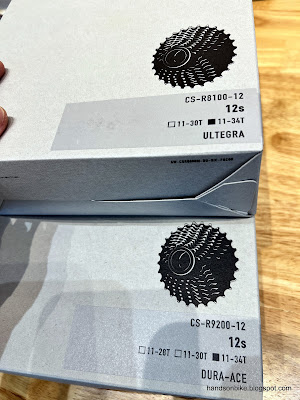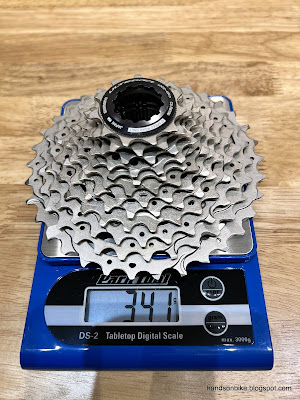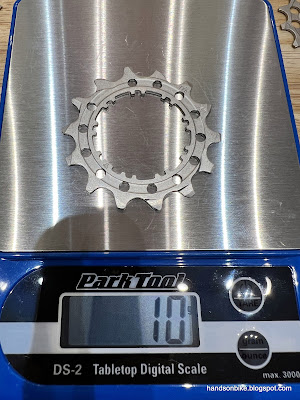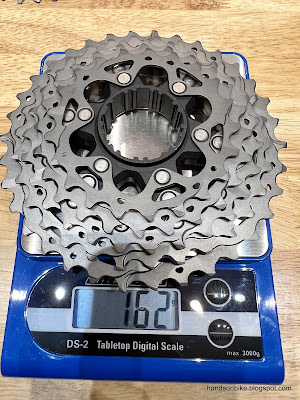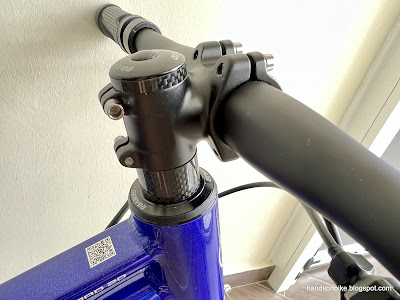One of the most common questions that cyclists ask is whether it is worth upgrading from an Ultegra cassette to a Dura-Ace cassette? The Dura-Ace cassette costs around 3 times more than the Ultegra version, which is a pretty big difference. Why is there such a big price difference?
Today I will compare the Dura-Ace R9200 12 speed cassette versus the Ultegra R8100 12 speed cassette. The cassette details can be found in the individual posts, as I will mainly be comparing the similarities and differences. If you like side by side comparisons, there are a lot more at this page.
Comparing the bigger 11-34T cassette instead of the 11-30T cassette.
Colour looks very different, due to the different materials and surface finishing used.
Dura-Ace cassette is on the right with some dark grey sprockets.
Construction is similar, as both use 2 spiders for 7 sprockets, while the other 5 sprockets are loose.
Ultegra CS-R8100 11-34T cassette weighs 341 grams. Heavier than the Dura-Ace and also the SRAM Force XG-1270 11-36T cassette.
Dura-Ace CS-R9200 11-34T cassette is much lighter at 256 grams. A whole 85 grams lighter.
Aluminium lock rings look similar, just with different laser engraving / pad printing.
The 11, 12, 13T sprockets are similar, but the larger sprockets are slightly different between the Dura-Ace and Ultegra versions.
On the Dura-Ace 14T sprocket (right), there is a groove cut into the sprocket to reduce a bit of weight.
Ultegra 14T sprocket is 12 grams.
The groove on the Dura-Ace 14T sprocket saves 2 grams.
The 12 speed B spacer is different. Dura-Ace uses the aluminium version on the right, while the Ultegra version uses a resin spacer.
Same for the 15T sprocket, the Dura-Ace version has a groove all around.
Ultegra 15T sprocket weighs 13 grams.
Dura-Ace version with groove is 1 gram lighter.
On the 11-34T cassette, there is no 16T sprocket. Instead, it is replaced by a 34T sprocket at the end to expand the gear range. Check out this post for a comparison between the 11-30T and 11-34T cassettes.
The 17-19T sprockets are riveted onto a small aluminium spider. The spider looks the same, but the sprockets are different!
The Dura-Ace version on the right has a titanium 19T sprocket that is riveted to the steel 17T sprocket, while both the sprockets on the Ultegra version are made of steel.
Ultegra 17-19T with both steel sprockets weigh 45 grams.
Dura-Ace version with a titanium 19T sprocket weighs 9 grams less.
Next, we move to the last spider on the cassette, where the 5 largest sprockets are riveted together. These 5 sprockets are 21-24-27-30-34T.
Dura-Ace uses titanium for its 6 largest sprockets, shown here are the 5 that are riveted together. Ultegra uses steel for all its sprockets.
Titanium sprockets have a smooth dark grey finish, compared to the sand blast satin nickel finish on the Ultegra sprockets.
Lots of rivets holding the 5 sprockets to the aluminium spider!
The Dura-Ace cassette spider on the right has a better looking surface finish, while the Ultegra version on the left looks rather unfinished.
If you look closely, the rivet head looks different! Dura-Ace uses rivets that are non-magnetic, which might be titanium, although it might also be stainless steel.
Ultegra cluster of 5 sprockets weigh 236 grams. This makes up the bulk of the Ultegra cassette weight (341 grams).
Dura-Ace cluster is much lighter at just 162 grams for the 5 largest sprockets! This is 74 grams lighter than the Ultegra cluster.
It is clear that most of the weight savings come from the cluster of 5 large sprockets, as this sub-unit alone accounts for 74 grams out of the total weight difference of 85 grams. This is possible due to the use of titanium sprockets, which are much lighter than steel sprockets.
Titanium has a density that is 4.5 kg/m3, compared to 7.8 kg/m3 for steel. If the material volume is the same, the titanium sprockets will weigh about 42% less than the steel sprockets. That is how the titanium sprockets enable big weight savings.
However, this comes as a cost, as titanium is much more expensive to procure and manufacture when compared to steel sprockets. This is part of the reason why the Dura-Ace cassette costs 3 times more than the Ultegra cassette, since half of the sprockets (6 out of 12) on the Dura-Ace cassette is made of titanium.
If you are looking for weight differences between the Dura-Ace and Ultegra groupset, the cassette contributes a big amount to it. Correspondingly, the cost difference is also big.
Is it worth paying more for the Dura-Ace cassette? Only if weight reduction is your priority. Otherwise, the Ultegra cassette would work just as well in terms of shifting performance and durability.
